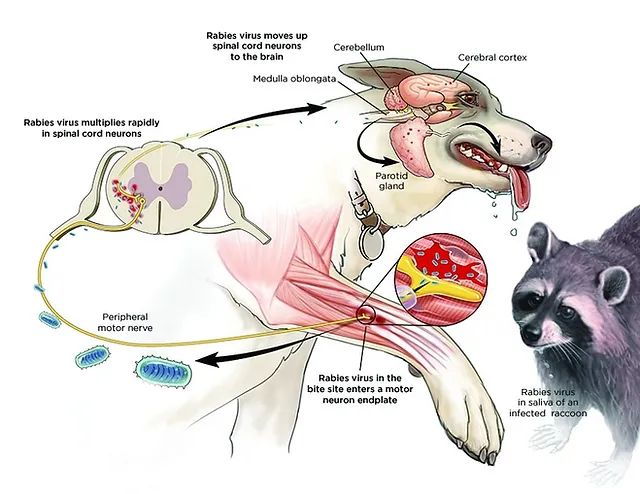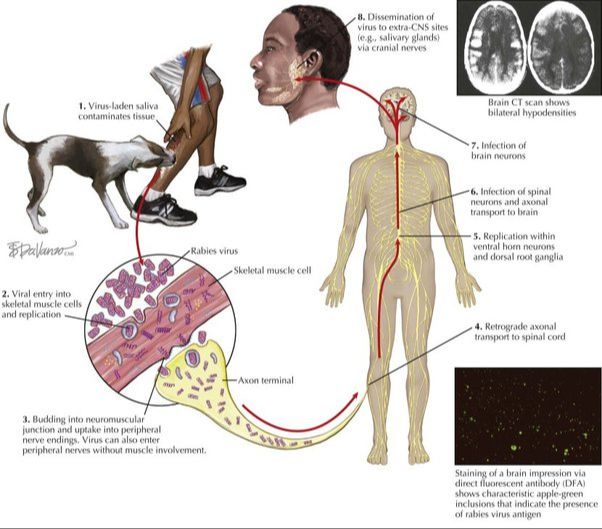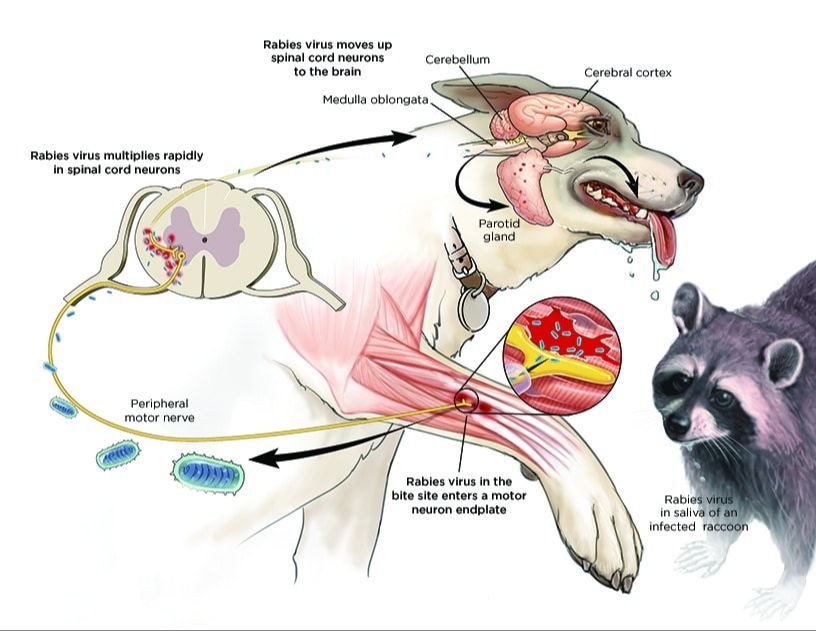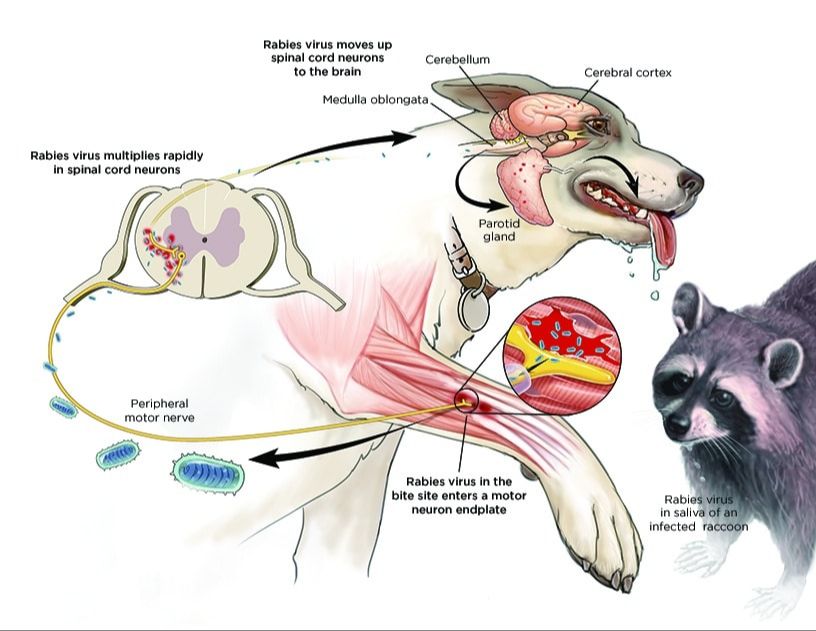Introduction
Rabies is a viral infection that affects the central nervous system of mammals, including dogs. It is spread through the saliva of an infected animal, usually via a bite wound. Rabies causes inflammation of the brain and spinal cord, leading to symptoms such as aggression, excessive salivation, paralysis and ultimately death.
While the most common way for rabies to be transmitted is through a bite from an infected animal, there are some rare cases where non-bite exposures can occur. Some documented ways rabies has spread without a bite are:
- Contact between a rabies-infected animal’s saliva or central nervous system tissue and open wounds or mucous membranes (eyes, nose, mouth)
- Inhalation of aerosolized rabies virus, such as in a cave with infected bats
- Ingestion of unpasteurized milk or meat from a rabid animal
While rare, these types of non-bite exposures have resulted in rabies infections in both animals and humans. This highlights the importance of avoiding contact with wildlife and getting pets vaccinated against rabies.
Saliva

The rabies virus is present in the saliva of infected animals. Transmission of rabies usually begins when infected saliva from a rabid animal enters the body of an uninfected animal (CDC, 2022). This most commonly occurs through a bite wound. However, transmission is also possible when the virus enters through membranes in the eyes, nose, mouth, or an open wound via licking or grooming behaviors.
Licking and grooming are common behaviors in animals. When an infected animal grooms or licks an open wound or mucous membrane of another animal, its saliva can transmit the rabies virus. Even when there is no bite, the virus can be passed through activities like an infected mother cat grooming her kittens. Therefore, rabies transmission is possible in animals through close contact without bites when the infected saliva enters the body (CDC, 2022).
Mucous Membranes
The mucous membranes, including the eyes, nose, and mouth, are common entry points for the rabies virus. Rabies can be transmitted through infected saliva coming into contact with mucous membranes (1). This can occur if an unvaccinated dog licks the eyes, nose, mouth or an open wound of a person. Even though no bite occurs, the virus present in the dog’s saliva can infect the person.

One case study documented rabies transmission through the mucous membranes in China in 2013. A 9-year-old boy contracted rabies after being licked in the eyes and lips by a puppy. The boy experienced symptoms within 20 days and died shortly after. Testing confirmed the puppy was infected with rabies, even though it had not displayed clinical signs at the time of contact (2).
The mucous membranes provide a direct pathway for the rabies virus to enter the body and nerves. Exposure to infected saliva on mucous membranes allows the virus to bypass the skin barrier and infect a person without a bite (3). Proper precautions should be taken around unvaccinated animals to avoid contact with the eyes, nose or mouth.
In Utero
An infected mother can transmit rabies to her unborn puppies in utero before birth. This occurs when the rabies virus crosses the placenta and infects the fetal nervous system. According to a study published in PubMed, “Mother-to-child transmission of rabies is possible, but rare, because rabies virus is not present in blood and exposure of the baby’s mucosa to infected maternal blood or secretions is minimal” (https://pubmed.ncbi.nlm.nih.gov/26947499/).

Newborn puppies infected with rabies in utero may show signs like tremors, seizures, paralysis, and death. The incubation period can be very short, sometimes just a few days from birth. According to research from Pasteur Institute, “Although rare cases of survival have been reported in patients exposed to bat rabies who developed a vigorous, early immune response, rabies in newborns is almost always fatal” (https://pasteur.hal.science/pasteur-01476328/document).
Unpasteurized Milk
Rabies can potentially be transmitted through unpasteurized milk from an infected mother. According to the CDC, “Transmission of rabies virus in unpasteurized milk is theoretically possible.” [1] If a mother dog, cat, cow, or other mammal has rabies and passes the virus into its milk supply, any offspring that ingests that milk could become infected.

This is a particular risk for newborn puppies. Puppies receive immunity through the mother’s milk, so ingesting milk from a rabid mother could transmit the virus. There are no direct cases demonstrating this type of transmission, but it remains theoretically possible. Pasteurizing milk kills the rabies virus and protects against this potential mode of transmission.
Organ Transplants
The rabies virus can be transmitted through infected transplant organs or tissues. There have been some rare documented cases of rabies transmission through solid organ transplantation in humans, including transplantation of kidneys, liver and lungs (https://www.ncbi.nlm.nih.gov/pmc/articles/PMC6000923/).
In one notable case in 2013, rabies was transmitted to three organ recipients from a donor who died from an unknown cause (https://www.cdc.gov/media/releases/2013/s0315_rabies_organs.html). The organ recipients did not show symptoms until more than a year later, after which they died. This long incubation period is unusual for rabies.
There are fewer documented cases of rabies transmission through organs in dogs. However, it is theoretically possible for an infected dog that asymptomatically carries rabies to transmit the virus to another dog through organ or tissue transplantation. Screening donor dogs for rabies prior to transplantation can help prevent spread through this route.
Infected Salivary Glands
Rabies virus infects the salivary glands of dogs and other animals. An analysis of rabid dog salivary glands found the virus largely concentrated in serous cells of the glands [1]. The virus replicates in the glands and can be shed in saliva even before symptoms appear. According to the CDC, rabies virus travels along nerves until reaching the salivary glands where it multiplies [2]. Shedding of the virus in saliva can occur days to weeks before onset of symptoms.
Nasal Discharges
Rabies virus can be transmitted through infected nasal fluids and discharges. According to the CDC, “Transmission of rabies virus usually begins when infected saliva of a host is passed to an uninfected animal; most commonly through a bite.” (CDC) Therefore, while bites are the most common method of transmission, the rabies virus present in nasal fluids and discharges can also lead to infection.
Specifically, activities like sneezing, breathing, coughing, or having a runny nose can release infected nasal fluids into the air or onto surfaces. If these fluids come into contact with open wounds, mucous membranes, or are inhaled by another animal, transmission is possible. Studies show rabies transmission through nasal and oral routes in animal models. (Charlton, 1979) Therefore, infected nasal discharges represent a potential non-bite route of rabies transmission if they contain enough viral load.
Oral Lesions
Lesions in the mouth like ulcers and wounds can harbor the rabies virus in saliva and other bodily fluids. Rabies can spread if an infected animal’s saliva comes into contact with these lesions or wounds through licking. According to the CDC, “Rabies virus may be introduced through fresh wounds, and a few cases of human-to-human rabies transmission have occurred following corneal and organ transplants.”
While extremely rare, there have been a few documented cases where humans contracted rabies through contact between infected saliva and open wounds or mucous membranes (Zhao et al., 2019). Care should be taken around animals that may potentially have rabies to avoid any contact between bodily fluids like saliva and any lesions, wounds or mucous membranes.
Sources:
– https://www.cdc.gov/rabies/transmission/index.html
– Zhao, H., Zhang, J., Zhen, W., … & Zhang, H. (2019). Rabies acquired through mucosal exposure, China, 2013. Emerging infectious diseases, 25(12), 2322.
Conclusion
As we’ve discussed, while being bitten by an infected animal is the most common way dogs contract rabies, there are other routes of transmission to be aware of. Dogs can potentially get rabies through contact with infected saliva, mucous membranes, unpasteurized milk, organ transplants from infected animals, and more.
However, the good news is that rabies is almost 100% preventable in dogs through vaccination. Ensuring your dog receives their puppy shots and stays current on their rabies vaccine is the best way to protect them from this deadly virus, regardless of the potential exposure route.
While non-bite transmission of rabies in dogs is very rare, it illustrates the importance of responsible pet ownership. By keeping your dog’s vaccinations up to date, avoiding contact with wildlife, and monitoring their health, you can help prevent rabies and keep your furry friend safe and healthy.
